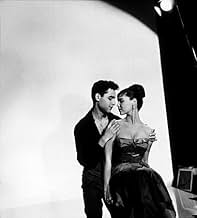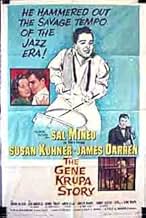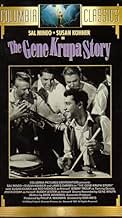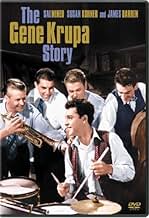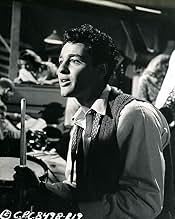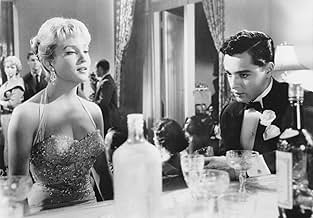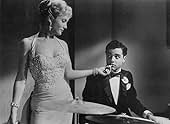NOTE IMDb
6,7/10
812
MA NOTE
Ajouter une intrigue dans votre langueBiopic of famous jazz drummer, Gene Krupa, who becomes a sensation but cannot handle success and life in the fast lane and ends-up broke, struggling with drugs and alcohol.Biopic of famous jazz drummer, Gene Krupa, who becomes a sensation but cannot handle success and life in the fast lane and ends-up broke, struggling with drugs and alcohol.Biopic of famous jazz drummer, Gene Krupa, who becomes a sensation but cannot handle success and life in the fast lane and ends-up broke, struggling with drugs and alcohol.
- Réalisation
- Scénario
- Casting principal
- Récompenses
- 1 victoire et 1 nomination au total
Stanley Adams
- Bar Owner
- (non crédité)
Marie Ardell
- Minor Role
- (non crédité)
Candy Barr
- Stripper
- (non crédité)
Arthur Berkeley
- Stagehand
- (non crédité)
John Bleifer
- Father
- (non crédité)
Avis à la une
Not historially accurate, but a great portrayal by Sal Mineo. He worked with Krupa for about 2 years before filming began. The only real flaw is that the music is a 1950's version of 1930's swing/jazz, and none of Krupa's hits of the 40's were really included. Nonetheless, the music is very good, with Mineo mimicing extremely accurately Krups's off screen drumming.
Competent, slick and well photographed, but fairly banal treatment of the famous drummer.
Almost no attempt is made to visually set the story in the twenties and thirties. Thus, the film abounds in an abundance of visual anachronisms, including fifties architecture, decor, and clothing, (Misses Kohner and Craig wear Dior style shirtwaist dirndls throughout, whilst Miss Oliver wears Capri style cocktail pants!--nowhere is there a cloche hat, aigrette or dropped waist). Only slight sartorial concessions are made for the men, (a few bowler hats and double breasted vests)
These inaccuracies no doubt accrue from the fact that the picture is being pitched wholesale to the 1959 teen audience and not to their parents.
For his part, Mr. Mineo does exceedingly well, though at times he does lapse into hipster posturing, (in his finger pointing angry scenes he appears to be imitating Ben Gazzara). Given his extreme youth, however, he demonstrates more poise and depth than his teen idol peers. The only really embarrassing moments come when he is depicted as a cassock clad seminarian in prayer.
If nothing else, this film provides your only chance to see Sal Mineo in spats.
Almost no attempt is made to visually set the story in the twenties and thirties. Thus, the film abounds in an abundance of visual anachronisms, including fifties architecture, decor, and clothing, (Misses Kohner and Craig wear Dior style shirtwaist dirndls throughout, whilst Miss Oliver wears Capri style cocktail pants!--nowhere is there a cloche hat, aigrette or dropped waist). Only slight sartorial concessions are made for the men, (a few bowler hats and double breasted vests)
These inaccuracies no doubt accrue from the fact that the picture is being pitched wholesale to the 1959 teen audience and not to their parents.
For his part, Mr. Mineo does exceedingly well, though at times he does lapse into hipster posturing, (in his finger pointing angry scenes he appears to be imitating Ben Gazzara). Given his extreme youth, however, he demonstrates more poise and depth than his teen idol peers. The only really embarrassing moments come when he is depicted as a cassock clad seminarian in prayer.
If nothing else, this film provides your only chance to see Sal Mineo in spats.
Sal Mineo, who made a career of played conflicted people, does a magnificent job in the biography of legendary drummer Gene Krupa.
Mineo, as Krupa, gets wonderful support from James Darren and Susan Kohner. 1959 was a remarkable year for Miss Kohner. It was that year where she received a best supporting actress nomination as the troubled daughter of Lana Turner's maid in that great film "Imitation of Life."
Krupa's family wanted him to enter the priesthood. However, Gene's calling was for being a drummer. As is the case with so many talented people, success came quickly and unable to handle it, Krupa descended into a life of drinking and using reefers. At a time, when there were investigations revolving about musicians and drugs, Krupa's career suffered from his conviction and serving time in prison.
While Mineo at age 20, may have been too young for the part, he does a very credible job as the tormented youth. Kohner, as his girlfriend, Ethel, never gave up on him even though he literally walked out on her before his troubles again. As she did in "Imitation of Life," Kohner shows her own emotional conflict. Her early retirement from films deprived Hollywood of an excellent talent.
We also lost a great talent, when Mineo, who would get possibly the best part of his career as Dov Landau,the following year, in "Exodus," was murdered in 1976.
Lawrence Dobkin, who in 1959, was an important player in the television series "The Untouchables," scores well here as a protégé of Krupa.
Celia Lovsky, who was so memorable in many old films, usually portraying elderly women, was wonderful in 2 scenes in portraying Krupa's disappointed but loving mother. Of course, a Jewish woman playing a Catholic mother, might have raised some eyebrows at that time.
This is an excellent film where the social mores of the time derailed Krupa's great talent and career.
Mineo, as Krupa, gets wonderful support from James Darren and Susan Kohner. 1959 was a remarkable year for Miss Kohner. It was that year where she received a best supporting actress nomination as the troubled daughter of Lana Turner's maid in that great film "Imitation of Life."
Krupa's family wanted him to enter the priesthood. However, Gene's calling was for being a drummer. As is the case with so many talented people, success came quickly and unable to handle it, Krupa descended into a life of drinking and using reefers. At a time, when there were investigations revolving about musicians and drugs, Krupa's career suffered from his conviction and serving time in prison.
While Mineo at age 20, may have been too young for the part, he does a very credible job as the tormented youth. Kohner, as his girlfriend, Ethel, never gave up on him even though he literally walked out on her before his troubles again. As she did in "Imitation of Life," Kohner shows her own emotional conflict. Her early retirement from films deprived Hollywood of an excellent talent.
We also lost a great talent, when Mineo, who would get possibly the best part of his career as Dov Landau,the following year, in "Exodus," was murdered in 1976.
Lawrence Dobkin, who in 1959, was an important player in the television series "The Untouchables," scores well here as a protégé of Krupa.
Celia Lovsky, who was so memorable in many old films, usually portraying elderly women, was wonderful in 2 scenes in portraying Krupa's disappointed but loving mother. Of course, a Jewish woman playing a Catholic mother, might have raised some eyebrows at that time.
This is an excellent film where the social mores of the time derailed Krupa's great talent and career.
If you've ever wanted to be a drummer this is the film for you. Even if the sounds of percussion instruments leave you with a pounding headache, it's still a good film to watch, for the acting and for the general atmosphere the film evokes.
With a straightforward, linear plot, "The Gene Krupa Story" highlights some of the career events of the legendary drummer, from his high school days in Chicago until his comeback from the depths, following an unfortunate incident in San Francisco. Krupa comes across in the film as outgoing, ambitious, single-minded, determined, and unable to handle success.
The story spans roughly a twenty year period from the late 1920s to the late 1940. Sal Mineo has the title role ... and what an acting job! In scenes with dialogue, his performance is intense, subtle, and very convincing. But, when Mineo mimics Krupa's frenetic drum solos, Mineo's performance is electrifying.
Both Susan Kohner as Krupa's love interest, and Susan Oliver as a femme fatale with attitude, further elevate the overall acting level. And the B&W cinematography from Charles Lawton, Jr., combined with smoke filled rooms and jazzy/blues music, is wonderfully suggestive of the beat generation of the 1950s, even though we are supposed to believe that it is an earlier era.
On the downside, the story is only partly factual. Production values are hardly better than average, and the editing is at times sloppy. The film has an inexplicably abrupt ending.
Overall, I recommend this film for the jazzy atmosphere of a bygone era, and especially for the high quality acting. "The Gene Krupa Story" is worth watching, if for no other reason than to marvel at Sal Mineo's ability to bang the drum briskly.
With a straightforward, linear plot, "The Gene Krupa Story" highlights some of the career events of the legendary drummer, from his high school days in Chicago until his comeback from the depths, following an unfortunate incident in San Francisco. Krupa comes across in the film as outgoing, ambitious, single-minded, determined, and unable to handle success.
The story spans roughly a twenty year period from the late 1920s to the late 1940. Sal Mineo has the title role ... and what an acting job! In scenes with dialogue, his performance is intense, subtle, and very convincing. But, when Mineo mimics Krupa's frenetic drum solos, Mineo's performance is electrifying.
Both Susan Kohner as Krupa's love interest, and Susan Oliver as a femme fatale with attitude, further elevate the overall acting level. And the B&W cinematography from Charles Lawton, Jr., combined with smoke filled rooms and jazzy/blues music, is wonderfully suggestive of the beat generation of the 1950s, even though we are supposed to believe that it is an earlier era.
On the downside, the story is only partly factual. Production values are hardly better than average, and the editing is at times sloppy. The film has an inexplicably abrupt ending.
Overall, I recommend this film for the jazzy atmosphere of a bygone era, and especially for the high quality acting. "The Gene Krupa Story" is worth watching, if for no other reason than to marvel at Sal Mineo's ability to bang the drum briskly.
10whpratt1
Always enjoy listening to the great talent of Gene Krupa along with Buddy Rich. This is a film dealing with Krupa's childhood which dealt with his becoming a Priest and then a world famous drummer in the 1940's. Sal Mineo, (Gene Krupa),"Rebel Without a Cause",'55, did a great job of trying to imitate Gene on the drums along with Susan Kohner,(Ethel Maguire),"Freud",'62, who was his girlfriend and loyal supporter through out this picture. This film portrays the good and bad times of Gene Krupa and most of his bad times were caused by a frustrating childhood and a great love of his mother and father, who both demanded too much from their son. Great Class film along with great musicians.
Le saviez-vous
- AnecdotesWhen the film opened in Krupa's hometown of Chicago at the Schiller Theatre on January 15, 1960 both Gene Krupa and Sal Mineo were on hand to greet the public and sign "fan fotos."
- GaffesWhen we see Gene at his penthouse on Central Park, at the party one of the guests is Bix Beiderbecke. Bix died in 1931 and only ever played with Gene Krupa in Chicago. By the time Krupa made it in New York, Bix had already died.
- Citations
Gene Krupa: Who's the snake charmer?
Dorissa Dinell: Anita O'Day. Not bad - if you like talent.
- ConnexionsFeatured in Police Story: The Broken Badge (1978)
Meilleurs choix
Connectez-vous pour évaluer et suivre la liste de favoris afin de recevoir des recommandations personnalisées
Détails
- Durée1 heure 41 minutes
- Couleur
- Rapport de forme
- 1.66 : 1
Contribuer à cette page
Suggérer une modification ou ajouter du contenu manquant

Lacune principale
By what name was La Vie ardente de Gene Krupa (1959) officially released in India in English?
Répondre


